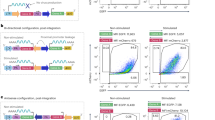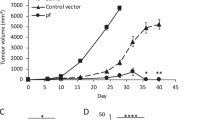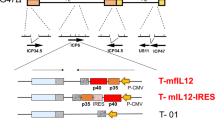Abstract
The gibbon ape leukaemia virus envelope fusogenic membrane glycoprotein (GALV FMG) is a highly potent cytotoxic gene with great potential for use in cancer gene therapy. Here, we show that production of a VSV-G pseudotyped lentiviral vector expressing GALV FMG reconciles the requirements of viral production with the cytotoxic effects of GALV in human cells and has high titres on both dividing and quiescent tumour cells. Direct intratumoral injection of these stocks eradicated progressively growing human tumour xenografts. The potent bystander effect of the FMG transgene is a major contributor to the success of this approach but immunological activation may also be a factor. To our knowledge, this is the first demonstration in vivo of the potential both of FMG and lentiviral vectors for cancer gene therapy and highlights the importance of exploring different vector systems to complement the biological properties of the therapeutic transgene.
This is a preview of subscription content, access via your institution
Access options
Subscribe to this journal
Receive 12 print issues and online access
$259.00 per year
only $21.58 per issue
Buy this article
- Purchase on Springer Link
- Instant access to full article PDF
Prices may be subject to local taxes which are calculated during checkout





Similar content being viewed by others
References
Vile RG, Russell S, Lemoine N . Cancer gene therapy: hard lessons and new courses Gene Therapy 2000 7: 2–8
Bateman A et al. Fusogenic membrane glycoproteins as a novel class of genes for the local and immune-mediated control of tumor growth Cancer Res 2000 60: 1492–1497
Fielding AK et al. A hyperfusogenic Gibbon Ape Leukaemia envelope glycoprotein: targeting of a cytotoxic gene by ligand display Hum Gene Ther 2000 11: 817–826
Januszeski MM et al. Functional analysis of the cytoplasmic tail of Moloney murine leukemia virus envelope protein J Virol 1997 71: 3613–3619
Melcher AA et al. Tumor immunogenicity is determined by the mechanism of cell death via induction of heat shock protein expression Nature Med 1998 4: 581–587
Todryk S et al. Heat shock protein 70 induced during tumor cell killing induces Th1 cytokines and targets immature dendritic cell precursors to enhance antigen uptake J Immunol 1999 163: 1398–1408
Ali M, Lemoine NR, Ring CJA . The use of DNA viruses as vectors for gene therapy Gene Therapy 1994 1: 367–384
Ram Z et al. Therapy of malignant brain tumors by intratumoral implantation of retroviral vector-producing cells Nature Med 1997 3: 1354–1361
Peng K-W, Vile R . Vector development for cancer gene therapy Tumor Targeting 1999 4: 3–11
Naldini L et al. Efficient transfer, integration and sustained long term expression of the transgene in adult rat brain injected with a lentiviral vector Proc Natl Acad Sci USA 1996 93: 11382–11388
Zufferey R et al. Multiply attenuated lentiviral vector achieves efficient gene delivery in vivo Nat Biotechnol 1997 15: 871–875
Naldini L et al. In vivo gene delivery and stable transduction of nondividing cells by a lentiviral vector Science 1996 272: 263–266
Trono D . Lentiviral vectors: turning a deadly force into a therapeutic agent Gene Therapy 2000 7: 20–23
Miller DG, Adam MA, Miller AD . Gene transfer by retrovirus vectors occurs only in cells that are actively replicating at the time of infection Mol Cell Biol 1990 10: 4239–4242
Moolten FL . Drug sensitivity (‘suicide’) genes for selective cancer chemotherapy Cancer Gene Ther 1994 1: 279–287
Pardoll DM . Paracrine cytokine adjuvants in cancer immunotherapy Annu Rev Immunol 1995 13: 399–415
Arai T et al. A new system for stringent, high-titer vesicular stomatitis virus G protein-pseudotyped retrovirus vector induction by introduction of Cre recombinase into stable prepackaging cell lines J Virol 1998 72: 1115–1121
Rivera VM et al. A humanized system for pharmacologic control of gene expression Nature Med 1996 2: 1028–1032
Chong H et al. Tumour cell expression of B7 costimulatory molecules and interleukin-12 or granulocyte–macrophage colony stimulating factor induces a local antitumour response and may generate systemic protective immunity Gene Therapy 1998 5: 223–232
Diaz RM, Eisen T, Hart IR, Vile RG . Exchange of viral promoter/enhancer elements with heterologous regulatory sequences generates targeted hybrid long terminal repeat vectors for gene therapy of melanoma J Virol 1998 72: 789–795
Rein A et al. Evidence for cooperation between murine leukemia virus Env molecules in mixed oligomers J Virol 1998 72: 3432–3435
Markowitz D, Goff S, Bank A . Construction and use of a safe and efficient amphotropic packaging cell line Virology 1988 167: 400–406
Cosset F-L et al. High-titer packaging cells producing recombinant retroviruses resistant to human serum J Virol 1995 69: 7430–7436
Burns JC et al. Vesicular stomatitis virus G glycoprotein pseudotyped retroviral vectors: concentration to very high titer and efficient gene transfer into mammalian and nonmammalian cells Proc Natl Acad Sci USA 1993 90: 8033–8037
Groh V, Steinle A, Bauer S, Spies T . Recognition of stress-induced MHC molecules by intestinal epithelial gammadelta T cells Science 1998 279: 1737–1740
Groh V et al. Broad tumor-associated expression and recognition by tumor-derived gamma delta T cells of MICA and MICB Proc Natl Acad Sci USA 1999 96: 6879–6884
Goldman MJ, Lee PS, Yang JS, Wilson JM . Lentiviral vectors for gene therapy of cystic fibrosis Hum Gene Ther 1997 8: 2261–2268
Takahashi M, Miyoshi H, Verma IM, Gage FH . Rescue from photoreceptor degeneration in the rd mouse by human immunodeficiency virus vector-mediated gene transfer J Virol 1999 73: 7812–7816
Gallichan WS et al. Lentivirus-mediated transduction of islet grafts with interleukin 4 results in sustained gene expression and protection from insulitis Hum Gene Ther 1998 9: 2717–2726
Culver KW et al. In vivo gene transfer with retroviral vector-producer cells for treatment of experimental brain tumors Science 1992 256: 1550–1552
Park F et al. Efficient lentiviral transduction of liver requires cell cycling in vivo Nat Genet 2000 24: 49–52
Morgenstern JP, Land H . Advanced mammalian gene transfer: high titre retroviral vectors with multiple drug selection markers and a complementary helper-free packaging cell line Nucleic Acids Res 1990 18: 3587–3596
Zufferey R et al. Self-inactivating lentivirus vector for safe and efficient in vivo delivery J Virol 1998 72: 9873–9880
Acknowledgements
We thank Suzanne Marie Facteau and Jill Ludvigson for experimental assistance, Francois Loic-Cosset for cell lines and Toni Higgins for expert secretarial assistance.
Author information
Authors and Affiliations
Rights and permissions
About this article
Cite this article
Diaz, R., Bateman, A., Emiliusen, L. et al. A lentiviral vector expressing a fusogenic glycoprotein for cancer gene therapy. Gene Ther 7, 1656–1663 (2000). https://doi.org/10.1038/sj.gt.3301277
Received:
Accepted:
Published:
Issue Date:
DOI: https://doi.org/10.1038/sj.gt.3301277
Keywords
This article is cited by
-
Enhanced axonal regeneration by transplanted Wnt3a-secreting human mesenchymal stem cells in a rat model of spinal cord injury
Acta Neurochirurgica (2017)
-
Systemic Delivery of Fusogenic Membrane Glycoprotein-expressing Neural Stem Cells to Selectively Kill Tumor Cells
Molecular Therapy (2013)
-
Active Adenoviral Vascular Penetration by Targeted Formation of Heterocellular Endothelial–epithelial Syncytia
Molecular Therapy (2011)
-
Fusogenic membrane glycoproteins induce syncytia formation and death in vitro and in vivo: a potential therapy agent for lung cancer
Cancer Gene Therapy (2010)
-
Generation of optimized and urokinase-targeted oncolytic Sendai virus vectors applicable for various human malignancies
Gene Therapy (2009)



